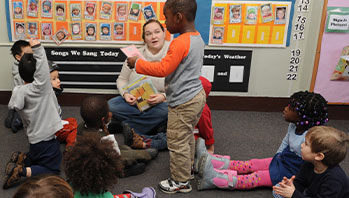- chart paper
- marker
- sentence strip
MA Standards:
English Language Arts/Foundational Skills/RF.PK.MA.1: With guidance and support, demonstrate understanding of the organization and basic features of printed and written text: books, words, letters, and the alphabet.
Head Start Outcomes:
Social Emotional Development/Self-Regulation: Follows simple rules, routines, and directions.
Language Development/Receptive Language: Attends to language during conversations, songs, stories, or other learning experiences.
PreK Learning Guidelines:
English Language Arts/Language 1: Observe and use appropriate ways of interacting in a group (taking turns in talking; listening to peers; waiting until someone is finished; asking questions and waiting for an answer; gaining the floor in appropriate ways).
Word Play: Segment Sentences #1

© Commonwealth of Massachusetts, Department of Early Education and Care (Jennifer Waddell photographer). All rights reserved.
ELA Focus Skills: Sentence Segmentation, Word Recognition
Help children practice segmenting words in a sentence.
Print the sentence “The engine goes down the hill” on a long strip of paper.
- Draw a vertical line between each word and leave an empty space between each word so that each is in its own “block.”
- Glue the sentence strip to chart paper. Focus children's attention on the chart and explain that you want them to look at each word as you read the sentence.
- Read the sentence aloud, pointing to each word as you say it. Make your hand “hop” from word to word to exaggerate the space between each word.
- Invite a volunteer to come to the chart paper. Hold the child’s hand and repeat the action as he or she says the words with you.
- Explain that all the words together make a sentence. Say, A sentence is made of words. Each word has its own space.
Ask children if they recognize any of the words from the week. (engine, down)
English Language Learners: Whenever possible, demonstrate word meanings with gestures, facial expressions, or motions. For example, if children are unfamilair with the word space, explain that a space is an area that does not have anything in it. Put two books on the table with a space in between. Point to the space in between the books and say, There is a space in between the two books. Nothing is in the space. Have children repeat after you. Then review the space in between the words in the chart.
